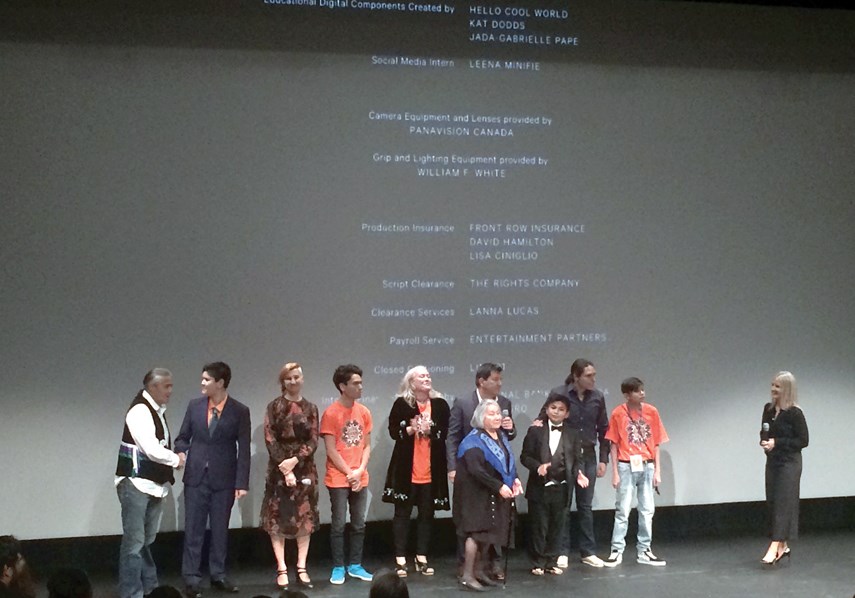Without a hope and a prayer, I dutifully headed to the back of the sinuous standby line for the premiere showing of Indian Horse at the Vancouver International Film Festival.
It had been sold out for days and I was angry at myself for not getting there earlier. As I chatted with other would-be moviegoers about the novel, Indian Horse and its author, Richard Wagamese, I realized how urgently – desperately – I wanted to see this movie. Since Wagamese’s death earlier this year (March 10), I had not taken the time to fully comprehend what he and his work meant to me and the world. His death was unfathomable. He was too young. He represented too much. He had been so magical and giving. How could this tragedy coincide so closely with the making of the movie, Indian Horse? It was ironic that his creative spirit should carry on without him being able to appreciate it. With these troubling thoughts in mind, I was offered a ticket to the show. Before anyone could change their mind, I quickly scrambled into the theatre and sat in the first seat available to me, which happened to be a platinum seat. I was in the epicentre of the theatre, surrounded by cast members and their family. Fully expecting to be ejected at any moment, I tried to emphasize my Métis heritage while looking as blasé as possible.
As this was Vancouver’s premiere of Indian Horse, we were treated to an introduction from the producers, Christine Haebler and Trish Dolman as well as the director, Stephen Campanelli. Their unbridled enthusiasm for the project was infectious. The cast were family members and Wagamese had been their father. Chills came over me when Edna Manitowabi, the actress playing Saul’s grandmother in the film, evocatively delivered a long and heartfelt prayer in her native Anishinaabe language. During this “smudging” ceremony Edna gifted us with the opportunity to grieve and celebrate at the same time. She spoke of her own experience as a victim of residential schools, saying, “It’s my truth. It is real. I wasn’t acting.” She expressed a message of hope and determination to move beyond tragedy to allow the “settler people” to be enlightened by their own past so that all could evolve and grow and that the mistakes of the past would not be repeated. Haebler echoed this sentiment noting that the novel was written with the goal of promoting understanding and growth. The producer explained, “Richard Wagamese believed in reconciliation. He believed that each and every one of us was part of that. He used the word, reconciliation as a verb. It’s an action that we can all undertake.”
The opening credits roll across the screen amid an atmosphere of love, loss and hope. From the initial scenes of northern Ontario lake country to the final image of Saul Indian Horse, the tale of one child’s voyage from the protection of a loving family to his indoctrination into a foreign and antagonistic culture is told with eloquence and care. The screenplay by Dennis Foon is scrupulously faithful to the novel while Campanelli captures the essence of Wagamese’s words in a sophisticated visual and emotional journey. We are swept away by the three stages of Saul’s life, performed by three incredibly talented actors (Sladen Peltier, Forrest Goodluck and Ajuawak Kapashesit): as a child he endures the hardships of residential school, as a teenager he finds escape through his love and talent for hockey, and as an adult he sinks into despair, feeling the brunt of the discrimination and disconnect he has faced as a First Nations man throughout his life.
Saul’s story is emblematic of the whole history of First Nations people in Canada. He begins his life in the warm embrace of his grandmother who grounds him with her knowledge of the land and its power. She teaches him the history of his people and he lives a simple life closely connected to nature. However, wrenched from her protection and taken to a residential school, he becomes victim to abuse in the name of assimilation. Saul forges a path forward by directing his energy to his love for hockey, but this cannot save him as he is burdened with the weight of discrimination and mistreatment. The film ends on a hopeful note as he reconnects with his foster family and acknowledges the extent of the damage that he has undergone. In order to move forward, Saul must face his past.
Indian Horse calls to mind another gem of Canadian film-making, The Rocket, for conveying the ignorance of the dominant culture in its promotion of systemic discrimination. While Maurice Richard is treated as a second-class citizen for being French-Canadian, Saul is almost destroyed by the abuse he has endured through loss of family, culture and self-worth. One of the most poignant moments in the film occurs when adult Saul is walking down the streets of an Ontario town and recognizes a shadow of a man living on the streets to be Lonnie, a classmate from residential school. Lonnie represents what could become of Saul. He represents all who have been lost to the effects of colonialism. Saul struggles with the ghosts of his past and desperately tries to kill his pain with alcohol, but he rises above the suffering.
Reconciliation comes through understanding, education and forgiveness. “Language is our soul,” said Saul’s grandmother. Remembering his grandmother’s words and his past, Saul validates his heritage. Edna Manitowabi’s Anishinaabe words of blessing linger with me as I contemplate the power of her people to withstand such hardship and still be smiling. With hope and a prayer, I exit the theatre, conscious of an urgent need to pass on the message of this incredible story. It is a story that needs to be told. The next showing is on Wednesday, Oct. 11. You will not be disappointed.



